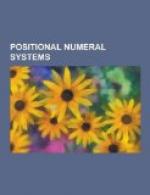|
This section contains 476 words (approx. 2 pages at 300 words per page) |

|
The binary number system is a method of representing numbers using positional notation and powers of 2. The decimal number system is similar, but employs powers of 10 rather than of 2. Consider, for example, the decimal number 451. The numerals 4, 5, and 1 are each understood--because of their notational positions--to be multiplied by specific powers of 10; that is, 451 = (4 x 102) + (5 x 101) + (1 x 100). Numbers expressed in the binary number system are interpreted similarly, except that the numerals 0 and 1 are used (rather than 0 through 9) and powers of 2 are used rather than powers of 10. The value of the binary number 101 can therefore be read off as (1 x 22) + (0 x 21) + (1 x 20). Adding these three terms reveals that binary 101 equals decimal 5.
The first known description of binary numbers was provided in 1679 by the mathematician Gottfried Wilhelm von Leibniz, who also constructed one of the earliest mechanical calculators. Leibniz wrote: "Despite its length [i.e...
|
This section contains 476 words (approx. 2 pages at 300 words per page) |

|


